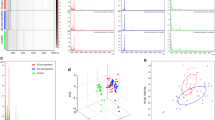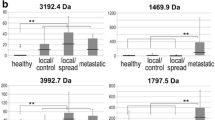Abstract
This study aimed to detect potential serum biomarkers for gastric cancer. In the present study, we used magnetic bead-based purification and matrix-assisted laser desorption/ionization time-of-flight (MALDI-TOF) mass spectrometry to detect potential serum markers in 70 gastric cancer (GC) patients compared with 72 healthy controls. On average, up to 81 peaks, of which 11 were significantly different m/z peaks (fold change >1.5; P < 0.001, Wilcoxon rank sum test) between GC group and healthy controls were detected. Two potential gastric serum biomarkers (m/z values of 1546.02 and 5335.08), with higher and specific expression in GC patients were further identified as peptide regions of SERPINA1 and ENOSF1. Enzyme-linked immunosorbent assays (ELISAs) were used to analyze 210 additional serum samples obtained from 36 healthy volunteers, 36 GC patients, 30 GU patients, 36 nonsmall-cell lung cancer (NSCLC) patients, 36 clear-cell renal cell carcinoma (CCRCC) patients, and 36 pancreatic cancer patients to verify the expression of SERPINA1 and ENOSF1 in GC sera. The suitability of the present method for gastric serum proteomic analysis was demonstrated and led to the identification of two peptide regions and their corresponding proteins as potential serum biomarkers for the serum detection of GC.






Similar content being viewed by others
References
Jemal A, Bray F, Center MM, Ferlay J, Ward E, Forman D. Global cancer statistics. CA Cancer J Clin. 2011;61:69–90.
Liu J, Sun LP, Gong YH, Yuan Y. Risk factors of precancerous gastric lesions in a population at high risk of gastric cancer. Chin J Cancer Res. 2010;22:267–73.
Kamangar F, Dores GM, Anderson WF. Patterns of cancer incidence, mortality, and prevalence across five continents: defining priorities to reduce cancer disparities in different geographic regions of the world. J Clin Oncol. 2006;24:2137–50.
Gastric Cancer Diagnosis and Treatment Expert Panel of the Chinese Ministry of Health. Chinese guidelines for diagnosis and treatment of gastric cancer (2011 edition. Transl Gastrointest Cancer. 2012;1:103–14.
GLOBOCAN 2008. Cancer Incidence and Mortality Worldwide (Internet). International Agency for Research on Cancer, World Health Organization, 2010. http://globocan.iarc.fr/. Accessed 9 Sept 2014.
Wu AW, Ji JF, Yang H, Li YN, Li SX, Zhang LH, et al. Long-term outcome of a large series of gastric cancer patients in China. Chin J Cancer Res. 2010;22:167–75.
Leung WK, Wu MS, Kakugawa Y, Kim JJ, Yeoh KG, Goh KL, et al. Screening for gastric cancer in Asia: current evidence and practice. Lancet Oncol. 2008;9:279–87.
Yu M, Zheng HC, Xia P, Takahashi H, Masuda S, Takano Y, et al. Comparison in pathological behaviours & prognosis of gastric cancers from general hospitals between China & Japan. Indian J Med Res. 2010;132:295–302.
Tao HQ, He XJ, Ma YY, Wang HJ, Xia YJ, Ye ZY, et al. Evalution of REG4 for early diagnosis and prognosis of gastric cancer. Hum Pathol. 2011;42:1401–9.
Oue N, Sentanil K, Noguchi T, Ohara S, Sakamoto N, Hayashi T, et al. Serum olfactomedin 4 (GW112, hGC-1) in combinationwith Reg IV is a sensitive biomarker for gastric cancer patients. Int J Cancer. 2009;125:2383–92.
Kochi M, Fujii M, Kanamori N, Kaiga T, Kawakami T, Aizaki K, et al. Evaluation of serum CEA and CA19-9 levels as prognostic factors in patients with gastric cancer. Gastric Cancer. 2000;3:177–86.
Palmblad M, Tiss A, Cramer R. Mass spectrometry in clinical proteomics—from the present to the future. Proteomics Clin Appl. 2009;13:6–17.
Yang J, Song YC, Song TS, Hu XY, Guo YM, Li ZF, et al. Identification of novel low-molecular-weight serum peptidome biomarkers for non-small-cell lung cancer (NSCLC). J Clin Lab Anal. 2012;26:148–54.
Yang J, Yang SY, Hu XY, Huo SF, Shang WL, Li ZF, et al. Serum peptidome profiling in patients with lung cancer. Anat Rec. 2010;293:2027–33.
Wang J, Wang XY, Lin SY, Chen CD, Wang CR, Ma QY, et al. Identification of Kininogen-1 as a serum biomarker for the early detection of advanced colorectal adenoma and colorectal cancer. PLos One. 2013;7:e70519.
Cho WC. Proteomics and translational medicine: molecular biomarkers for cancer diagnosis, prognosis and prediction of therapy outcome. Expert Rev Proteomics. 2011;8:1–4.
Raimondo F, Salemi C, Chinello C, Daniela F, Morosi L, Rocco F, et al. Proteomic analysis in clear cell renal cell carcinoma: identification of differentially expressed protein by 2-D DIGE. Mol Biosyst. 2012;8:1040–51.
Hosoya N, Sakumotoa M, Nakamura Y, Narisawa T, Bilim V, Motoyama T, et al. Proteomics identified nuclear N-myc downstream-regulated gene 1 as a prognostic tissue biomarker candidate in renal cell carcinoma. Biochim Biophys. 2013;1834:2630–9.
Jones EE, Powers TW, Neely BA, Cazares LH, Troyer DA, Parker AS, et al. MALDI imaging mass spectrometry profiling of proteins and lipids in clear cell renal cell carcinoma. Proteomics. 2014;14:924–35.
Villanueva J, Shaffer DR, Philip J, Chaparro CA, Erdjument-Bromage H, Olshen AB, et al. Differential exoprotease activities confer tumor-specific serum peptidome patterns. J Clin Invest. 2006;116:271–84.
Li P, Yang J, Ma QY, Wu Z, Huang C, Li XQ, et al. Biomarkers screening between preoperative and postoperative patients in pancreatic cancer. Asian Pac J Cancer Prev. 2013;14:4161–5.
Liu J, Yin L, Dong HQ, Xu EH, Zhang L, Qiao YC, et al. Decreased serum levels of nucleolin protein fragment, as analyzed by bead-based proteomic technology, in multiple sclerosis patients compared to controls. J Neuroimmunol. 2012;250:71–6.
Bai J, He AL, Zhang WG, Huang C, Yang J, Yang Y, et al. Potential biomarkers for adult acute myeloid leukemia minimal residual disease assessment searched by serum peptidome profiling. Proteome Sci. 2013;11:39.
Fiedler GM, Baumann S, Leichtle A, Oltmann A, Kase J, Thiery J, et al. Standardized peptidome profiling of human urine by magnetic bead separation and matrix-assisted laser desorption/ionization time-of-flight mass spectrometry. Clin Chem. 2007;53:421–8.
Schaub NP, Jones KJ, Nyalwidhe JO, Cazares LH, Karbassi ID, Semmes OJ, et al. Serum proteomic biomarker discovery reflective of stage and obesity in breast cancer patients. J Am Coll Surg. 2009;5:970–8.
Schwamborn K, Krieg RC, Grosse J, Reulen N, Weiskirchen R, Knuechel R, et al. Serum proteomic profiling in patients with bladder cancer. Eur Urol. 2009;56:989–99.
Gettins PG. Serpin structure, mechanism, and function. Chem Rev. 2002;102:4751–804.
Van Gent D, Sharp P, Morgan K, Kalsheker N. Serpins: structure, function and molecular evolution. Int J Biochem Cell Biol. 2003;35:1536–47.
Normandin K, Péant B, Le Page C, Ladurantaye MD, Ouellet V, Tonin PN, et al. Protease inhibitor SERPINA1 expression in epithelial ovarian cancer. Clin Exp Metastasis. 2010;27:55–69.
Qin X, Chen QP, Sun C, Wang C, Peng QL, Xie L, et al. High-throughput screening of tumor metastatic-related differential glycoprotein in hepatocellular carcinoma by iTRAQ combines lectin-related techniques. Med Oncol. 2013;30:420–6.
Lu Y, Liu P, Wen W, Grubbs CJ, Townsend RR, Malone JP, et al. Cross-species comparison of orthologous gene expression in human bladder cancer and carcinogen-induced rodent models. Am J Transl Res. 2010;3:8–27.
Hsu PI, Chen CH, Hsiao M, Wu DC, Lin CY, Lai KH, et al. Diagnosis of gastric malignancy using gastric juice alpha1-antitrypsin. Cancer Epidemiol Biomarkers Prev. 2010;19:405–11.
He QY, Cheung YH, Leung SY, Yuen ST, Chu KM, Chiu JF. Diverse proteomic alterations in gastric adenocarcinoma. Proteomics. 2004;4:3276–87.
Conflicts of interest
None
Funding
This work was supported by the National Natural Science Foundation of China (grant number 81200845) and the Key Science and Technology Program of Shaanxi province (grant number 2012 K13-02-01).
Author information
Authors and Affiliations
Corresponding author
Rights and permissions
About this article
Cite this article
Yang, J., Xiong, X., Wang, X. et al. Identification of peptide regions of SERPINA1 and ENOSF1 and their protein expression as potential serum biomarkers for gastric cancer. Tumor Biol. 36, 5109–5118 (2015). https://doi.org/10.1007/s13277-015-3163-2
Received:
Accepted:
Published:
Issue Date:
DOI: https://doi.org/10.1007/s13277-015-3163-2




